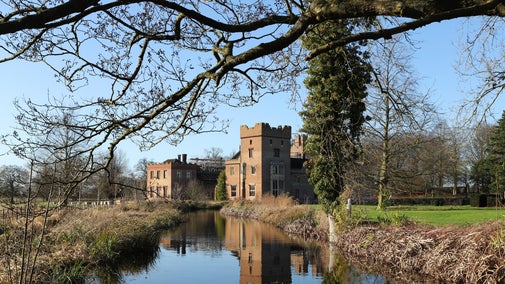
Donate
Everyone needs nature, now more than ever. Donate today and you could help people and nature to thrive at the places we care for.

Our climate is changing at a faster rate than ever, and nature is in trouble. The challenge ahead is huge, but the Stroud Landscape Project is responding to the nature and climate emergencies by creating more spaces for nature.
As one of the National Trust’s most pioneering partnership-based conservation projects, we’re creating a lasting landscape legacy by thinking and delivering big.
Wildflower grasslands are being created, ancient woodlands restored, wildlife corridors established, and lost species reintroduced.
With the town of Stroud in Gloucestershire at its centre, the project extends as far as Crickley Hill in the north to Wotton-under-Edge in the south. The area is renowned for rare species, like the Duke of Burgundy butterfly, pasqueflower and greater horseshoe bats.
We’re in danger of losing some of the west Cotswolds’ most vulnerable species for ever as important habitats are being lost through changes to land management practices and pressures from developers.
It’s not too late to save nature but we need to act quickly and work together. Providing plants and animals with the right conditions could help them come back from the brink of extinction.
To find out more about the project as a whole, watch our video via the link: https://bit.ly/4agKLL4
Calcareous grasslands are amongst the most species-rich habitats in the country. They provide homes for many flowering plants, such as orchids, as well as rare insects and butterflies.
Since the 1930s, the Cotswolds has lost over 96% of its species-rich grasslands. Restoring these grasslands is fundamental to the Stroud Landscape Project. Practices such as grazing and cutting are crucial. We’re also recreating traditional hay meadows that support native wildflowers.

Donate to the Stroud Landscape Project today and help us restore precious habitats and create more spaces for nature in the Stroud Valleys.
You can see our herd of Belted Galloway cattle happily munching across the project area. This isn’t just happening on National Trust land, it’s also taking place on important wildlife sites owned privately or managed by other organisations such as Natural England, Butterfly Conservation and Gloucestershire Wildlife Trust.
This traditional way of managing grasslands, without the use of harmful pesticides, creates a range of heights in the grass sward increasing the diversity of wildflowers and insects.
Wildlife corridors, like hedgerows and wildflower strips around field margins join habitats together and help wildlife move between them. For example, bats find their way using woodland edges, trees and hedgerows or ‘corridors’ to forage for food.
The project has been restoring, creating and connecting habitats together between Woodchester Park and Minchinhampton and Rodborough Commons to help greater horseshoe bats move between their summer roost site in Woodchester Mansion and winter sites located in mines on the edge of the commons.
Innovative partnerships forged by the project to create and restore grasslands in the Stroud valleys led to the largest ever UK reintroduction of the globally endangered Large Blue butterfly on Rodborough Common in 2020.

We’re restoring and creating more areas of grassland by sowing wildflower and native grass seeds. We collect some of this seed from a network of donor sites on and off our land.
Over the next few years, we’ll be collecting more seed from local meadows to sow on recipient sites belonging to the National Trust and local landowners.

With a dedicated, highly knowledgeable, and experienced team including a Delivery Manager, Senior Farm Manager, Area Ranger and Ranger, we’re able to offer landowners in the project area a variety of different services. Services include free UKHAB habitat surveys and written reports, land management prescriptions, habitat monitoring, site preparation prior to any restoration interventions, conservation, on-going support and exclusive learning and sharing events.
We’re not just working with landowners, we’re also working with communities in the town of Stroud to create green stepping-stones that link and connect our work in the landscape, forming vital nature corridors through the urban centre.
We’ve achieved a lot in the past few years. Here are just some of our highlights;
Our work is made possible thanks to our brilliant volunteers, supportive landowners and delivery partners and the generosity of donors and funders. Special mentions go to Cotswolds National Landscape, Farming in Protected Landscapes, Stroud Valleys Project, Wild Stroud, National Highways, Butterfly Conservation, Gloucestershire Wildlife Trust, Natural England, Stroud District Council and Severn Trent Water for supporting our work.
Please get in touch if you’re interested in getting involved and finding out more about the Stroud Landscape Project.
For more information, email the Stroud Landscape Project team at cotswolds@nationaltrust.org.uk.

Everyone needs nature, now more than ever. Donate today and you could help people and nature to thrive at the places we care for.
Discover more about the conservation work at Minchinhampton and Rodborough Commons, in the Cotswolds. Learn how a rare blue butterfly made its return to the area.

Learn how the National Trust works in collaboration with the Minchinhampton and Rodborough Commons Advisory Committee to protect and conserve these areas for everyone, for ever.
Find out more about the funding the National Trust receives from grants, and the projects it has helped support.

We believe that nature, beauty and history are for everyone. That’s why we’re supporting wildlife, protecting historic sites and more. Find out about our work.
